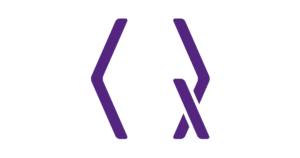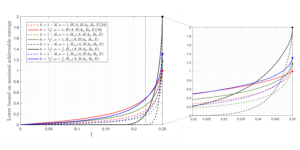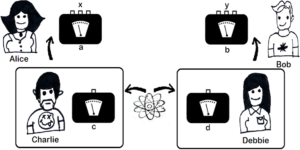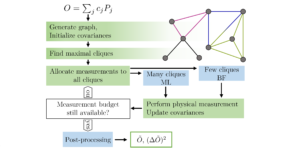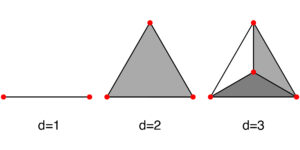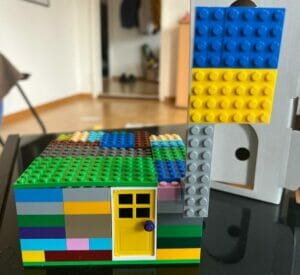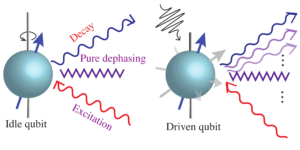Google Quantum AI, Santa Barbara, California 93117, USA
Find this paper interesting or want to discuss? Scite or leave a comment on SciRate.
Abstract
In this paper, I cut the cost of Y basis measurement and initialization in the surface code by nearly an order of magnitude. Fusing twist defects diagonally across the surface code patch reaches the Y basis in $lfloor d/2 rfloor + 2$ rounds, without leaving the bounding box of the patch and without reducing the code distance. I use Monte Carlo sampling to benchmark the performance of the construction under circuit noise, and to analyze the distribution of logical errors. Cheap inplace Y basis measurement reduces the cost of S gates and magic state factories, and unlocks Pauli measurement tomography of surface code qubits on space-limited hardware.
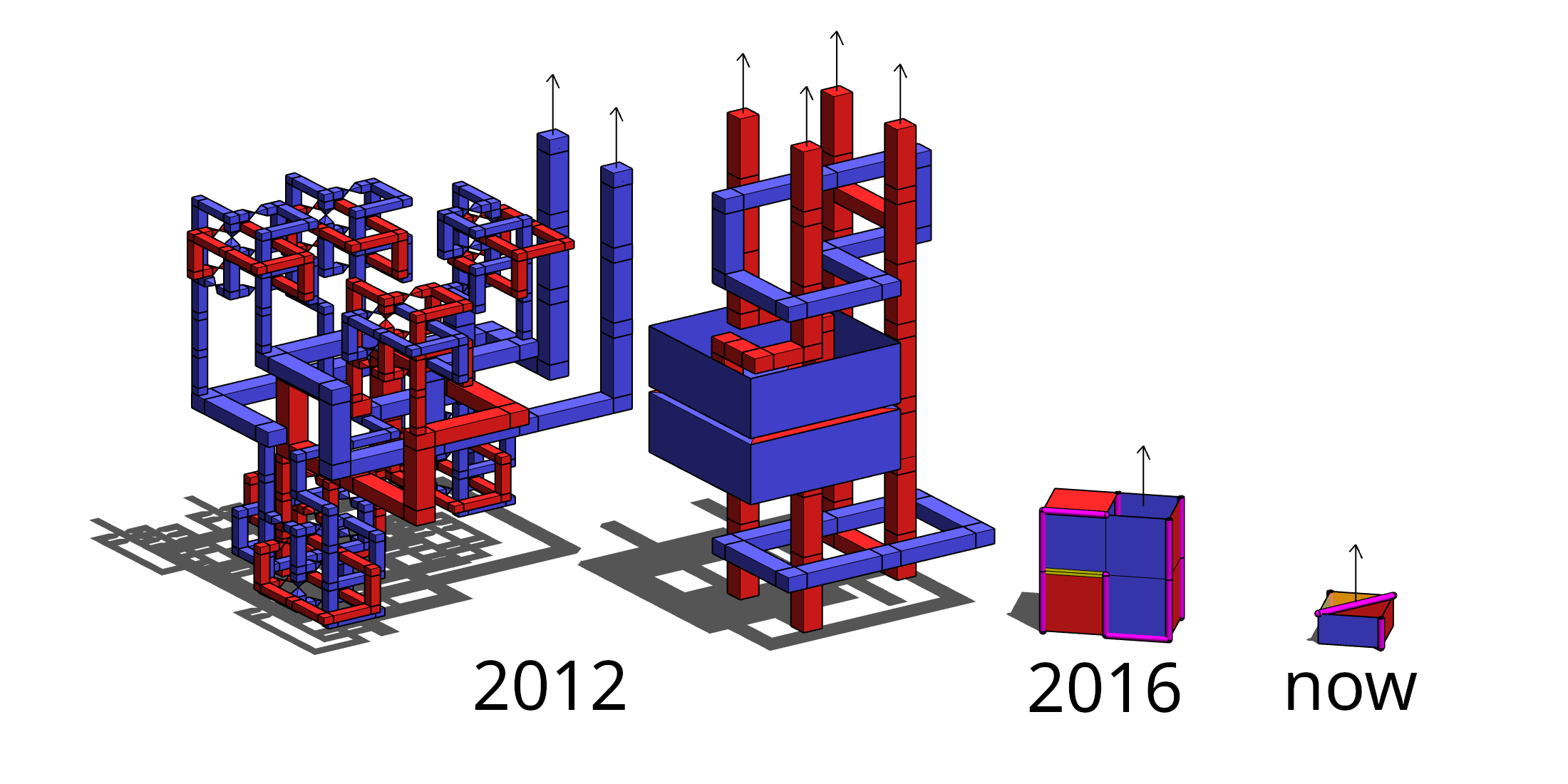
Featured image: A historical progression of defect diagrams, showing how the cost of reaching the surface code Y basis has improved dramatically over time.
Popular summary
► BibTeX data
► References
[1] Panos Aliferis, Daniel Gottesman, and John Preskill, “Quantum accuracy threshold for concatenated distance-3 codes” arXiv preprint quant-ph/0504218 (2005).
https://doi.org/10.48550/arXiv.quant-ph/0504218
[2] Christian Kraglund Andersen, Ants Remm, Stefania Lazar, Sebastian Krinner, Nathan Lacroix, Graham J. Norris, Mihai Gabureac, Christopher Eichler, and Andreas Wallraff, “Repeated quantum error detection in a surface code” Nature Physics 16, 875–880 (2020).
https://doi.org/10.1038/s41567-020-0920-y
[3] Hector Bombin, Chris Dawson, Ryan V Mishmash, Naomi Nickerson, Fernando Pastawski, and Sam Roberts, “Logical blocks for fault-tolerant topological quantum computation” arXiv preprint arXiv:2112.12160 (2021).
https://doi.org/10.48550/arXiv.2112.12160
[4] Benjamin J Brown, Katharina Laubscher, Markus S Kesselring, and James R Wootton, “Poking holes and cutting corners to achieve Clifford gates with the surface code” Physical Review X 7, 021029 (2017).
https://doi.org/10.1103/PhysRevX.7.021029
[5] Christopher Chamberlandand Earl T Campbell “Universal quantum computing with twist-free and temporally encoded lattice surgery” PRX Quantum 3, 010331 (2022).
https://doi.org/10.1103/PRXQuantum.3.010331
[6] Austin G Fowlerand Simon J Devitt “A bridge to lower overhead quantum computation” arXiv preprint arXiv:1209.0510 (2012).
https://doi.org/10.48550/arXiv.1209.0510
[7] Austin G Fowlerand Craig Gidney “Low overhead quantum computation using lattice surgery” arXiv preprint arXiv:1808.06709 (2018).
https://doi.org/10.48550/arXiv.1808.06709
[8] A. G. Fowler, M. Mariantoni, J. M. Martinis, and A. N. Cleland, “Surface codes: Towards practical large-scale quantum computation” Phys. Rev. A 86, 032324 (2012) arXiv:1208.0928.
https://doi.org/10.1103/PhysRevA.86.032324
[9] Daniel Gottesmanand Isaac L Chuang “Demonstrating the viability of universal quantum computation using teleportation and single-qubit operations” Nature 402, 390 (1999).
https://doi.org/10.1038/46503
[10] Craig Gidneyand Martin Ekerå “How to factor 2048 bit RSA integers in 8 hours using 20 million noisy qubits” Quantum 5, 433 (2021).
https://doi.org/10.22331/q-2021-04-15-433
[11] Craig Gidneyand Austin Fowler “A slightly smaller surface code S gate” arXiv preprint arXiv:1708.00054 (2017).
https://doi.org/10.48550/arXiv.1708.00054
[12] Craig Gidneyand Austin G Fowler “Efficient magic state factories with a catalyzed CCZ to 2T transformation” Quantum 3, 135 (2019).
https://doi.org/10.22331/q-2019-04-30-135
[13] Craig Gidney, Michael Newman, Austin Fowler, and Michael Broughton, “A fault-tolerant honeycomb memory” Quantum 5, 605 (2021).
https://doi.org/10.22331/q-2021-12-20-605
[14] Craig Gidney “Stim: a fast stabilizer circuit simulator” Quantum 5, 497 (2021).
https://doi.org/10.22331/q-2021-07-06-497
[15] Craig Gidney “Stability Experiments: The Overlooked Dual of Memory Experiments” Quantum 6, 786 (2022).
https://doi.org/10.22331/q-2022-08-24-786
[16] Craig Gidney “Data for “Inplace Access to the Surface Code Y Basis”” Zenodo (2023).
https://doi.org/10.5281/zenodo.7487893
[17] Thomas Häner, Samuel Jaques, Michael Naehrig, Martin Roetteler, and Mathias Soeken, “Improved quantum circuits for elliptic curve discrete logarithms” Post-Quantum Cryptography: 11th International Conference, PQCrypto 2020, Paris, France, April 15–17, 2020, Proceedings 12100, 425 (2020).
https://doi.org/10.1007/978-3-030-44223-1_23
[18] Clare Horsman, Austin G Fowler, Simon Devitt, and Rodney Van Meter, “Surface code quantum computing by lattice surgery” New Journal of Physics 14, 123011 (2012).
https://doi.org/10.1088/1367-2630/14/12/123011
[19] Aleksander Kubica, Beni Yoshida, and Fernando Pastawski, “Unfolding the color code” New Journal of Physics 17, 083026 (2015).
https://doi.org/10.1088/1367-2630/17/8/083026
[20] Daniel Litinski “A game of surface codes: Large-scale quantum computing with lattice surgery” arXiv preprint arXiv:1808.02892 (2018).
[21] Matt McEwen, Dave Bacon, and Craig Gidney, “Relaxing Hardware Requirements for Surface Code Circuits using Time-dynamics” (2023).
https://doi.org/10.48550/ARXIV.2302.02192
https://arxiv.org/abs/2302.02192
[22] Jonathan E Moussa “Transversal Clifford gates on folded surface codes” Physical Review A 94, 042316 (2016).
https://doi.org/10.1103/PhysRevA.94.042316
[23] Brett Victor “Media for Thinking the Unthinkable” (2013) [Online; accessed 12-Dec-2022].
http://worrydream.com/#!/MediaForThinkingTheUnthinkable
[24] Adam Jozef Zalcman, Alan Derk, Alan Ho, Alex Opremcak, Alexander Korotkov, Alexandre Bourassa, Andre Gregory Petukhov, Andreas Bengtsson, Andrew Dunsworth, Anthony Megrant, Austin Fowler, Bálint Pató, Benjamin Chiaro, Benjamin Villalonga, Brian Burkett, Brooks Riley Foxen, Catherine Erickson, Charles Neill, Chris Quintana, Cody Jones, Craig Michael Gidney, Daniel Eppens, Daniel Sank, Dave Landhuis, David A Buell, Doug Strain, Dvir Kafri, Edward Farhi, Eric Ostby, Erik Lucero, Evan Jeffrey, Fedor Kostritsa, Frank Carlton Arute, Hartmut Neven, Igor Aleiner, Jamie Yao, Jarrod Ryan McClean, Jeremy Patterson Hilton, Jimmy Chen, Jonathan Arthur Gross, Joseph Bardin, Josh Mutus, Juan Atalaya, Julian Kelly, Kevin Miao, Kevin Satzinger, Kostyantyn Kechedzhi, Kunal Arya, Marco Szalay, Marissa Giustina, Masoud Mohseni, Matt McEwen, Matt Trevithick, Matthew Neeley, Matthew P Harrigan, Michael Broughton, Michael Newman, Murphy Yuezhen Niu, Nicholas Bushnell, Nicholas Redd, Nicholas Rubin, Ofer Naaman, Orion Martin, Paul Victor Klimov, Pavel Laptev, Pedram Roushan, Ping Yeh, Rami Barends, Roberto Collins, Ryan Babbush, Sabrina Hong, Sean Demura, Sean Harrington, Seon Kim, Sergei Isakov, Sergio Boixo, Ted White, Thomas E O’Brien, Trent Huang, Trevor Mccourt, Vadim Smelyanskiy, Vladimir Shvarts, William Courtney, Wojtek Mruczkiewicz, Xiao Mi, Yu Chen, and Zhang Jiang, “Exponential suppression of bit or phase flip errors with repetitive quantum error correction” Nature (2021).
https://doi.org/10.1038/s41586-021-03588-y
[25] Youwei Zhao, Yangsen Ye, He-Liang Huang, Yiming Zhang, Dachao Wu, Huijie Guan, Qingling Zhu, Zuolin Wei, Tan He, Sirui Cao, Fusheng Chen, Tung-Hsun Chung, Hui Deng, Daojin Fan, Ming Gong, Cheng Guo, Shaojun Guo, Lianchen Han, Na Li, Shaowei Li, Yuan Li, Futian Liang, Jin Lin, Haoran Qian, Hao Rong, Hong Su, Lihua Sun, Shiyu Wang, Yulin Wu, Yu Xu, Chong Ying, Jiale Yu, Chen Zha, Kaili Zhang, Yong-Heng Huo, Chao-Yang Lu, Cheng-Zhi Peng, Xiaobo Zhu, and Jian-Wei Pan, “Realization of an Error-Correcting Surface Code with Superconducting Qubits” Physical Review Letters 129 (2022).
https://doi.org/10.1103/physrevlett.129.030501
Cited by
[1] Jiaxuan Zhang, Yu-Chun Wu, and Guo-Ping Guo, “Facilitating Practical Fault-tolerant Quantum Computing Based on Color Codes”, arXiv:2309.05222, (2023).
[2] Yangsen Ye, Tan He, He-Liang Huang, Zuolin Wei, Yiming Zhang, Youwei Zhao, Dachao Wu, Qingling Zhu, Huijie Guan, Sirui Cao, Fusheng Chen, Tung-Hsun Chung, Hui Deng, Daojin Fan, Ming Gong, Cheng Guo, Shaojun Guo, Lianchen Han, Na Li, Shaowei Li, Yuan Li, Futian Liang, Jin Lin, Haoran Qian, Hao Rong, Hong Su, Shiyu Wang, Yulin Wu, Yu Xu, Chong Ying, Jiale Yu, Chen Zha, Kaili Zhang, Yong-Heng Huo, Chao-Yang Lu, Cheng-Zhi Peng, Xiaobo Zhu, and Jian-Wei Pan, “Logical Magic State Preparation with Fidelity beyond the Distillation Threshold on a Superconducting Quantum Processor”, Physical Review Letters 131 21, 210603 (2023).
[3] Craig Gidney, Michael Newman, Peter Brooks, and Cody Jones, “Yoked surface codes”, arXiv:2312.04522, (2023).
[4] Gyorgy P. Geher, Ophelia Crawford, and Earl T. Campbell, “Tangling schedules eases hardware connectivity requirements for quantum error correction”, arXiv:2307.10147, (2023).
[5] Nick S. Blunt, György P. Gehér, and Alexandra E. Moylett, “Compilation of a simple chemistry application to quantum error correction primitives”, Physical Review Research 6 1, 013325 (2024).
[6] Craig Gidney, “Cleaner magic states with hook injection”, arXiv:2302.12292, (2023).
[7] Michael E. Beverland, Shilin Huang, and Vadym Kliuchnikov, “Fault tolerance of stabilizer channels”, arXiv:2401.12017, (2024).
[8] György P. Gehér, Campbell McLauchlan, Earl T. Campbell, Alexandra E. Moylett, and Ophelia Crawford, “Error-corrected Hadamard gate simulated at the circuit level”, arXiv:2312.11605, (2023).
[9] György P. Gehér, Ophelia Crawford, and Earl T. Campbell, “Tangling Schedules Eases Hardware Connectivity Requirements for Quantum Error Correction”, PRX Quantum 5 1, 010348 (2024).
The above citations are from SAO/NASA ADS (last updated successfully 2024-04-09 03:49:08). The list may be incomplete as not all publishers provide suitable and complete citation data.
On Crossref’s cited-by service no data on citing works was found (last attempt 2024-04-09 03:49:06).
This Paper is published in Quantum under the Creative Commons Attribution 4.0 International (CC BY 4.0) license. Copyright remains with the original copyright holders such as the authors or their institutions.
- SEO Powered Content & PR Distribution. Get Amplified Today.
- PlatoData.Network Vertical Generative Ai. Empower Yourself. Access Here.
- PlatoAiStream. Web3 Intelligence. Knowledge Amplified. Access Here.
- PlatoESG. Carbon, CleanTech, Energy, Environment, Solar, Waste Management. Access Here.
- PlatoHealth. Biotech and Clinical Trials Intelligence. Access Here.
- Source: https://quantum-journal.org/papers/q-2024-04-08-1310/
- :has
- :is
- :not
- ][p
- 06
- 08
- 1
- 10
- 11
- 1100
- 11th
- 12
- 13
- 135
- 14
- 15%
- 16
- 17
- 19
- 1999
- 20
- 2005
- 2012
- 2013
- 2015
- 2016
- 2017
- 2018
- 2019
- 2020
- 2021
- 2022
- 2023
- 2024
- 22
- 23
- 24
- 25
- 425
- 49
- 7
- 8
- 9
- a
- above
- ABSTRACT
- access
- accessed
- accuracy
- Achieve
- across
- Adam
- affiliations
- AI
- Alan
- alex
- Alexander
- All
- an
- analyze
- and
- andre
- Andrew
- Another
- Anthony
- Application
- apr
- April
- ARE
- Arthur
- arya
- AS
- At
- attempt
- austin
- author
- authors
- based
- basis
- BE
- because
- Benchmark
- Benjamin
- Beyond
- Bit
- Blocks
- Box
- Break
- Brian
- BRIDGE
- brown
- but
- by
- california
- campbell
- cao
- Catherine
- channels
- Chao-Yang Lu
- Charles
- cheap
- chemistry
- chen
- Cheng
- chong
- Chris
- christian
- Christopher
- cleaner
- code
- codes
- color
- come
- comment
- Common
- Commons
- complete
- computation
- computers
- computing
- Conference
- Connectivity
- construction
- copyright
- corners
- Cost
- Craig
- cryptography
- curve
- Cut
- cuts
- cutting
- Daniel
- data
- Dave
- David
- Detection
- diagrams
- discuss
- distance
- distribution
- do
- doug
- down
- dramatically
- dual
- e
- Eases
- easy
- Edward
- Elliptic
- encoded
- eric
- erik
- error
- Errors
- evan
- experiments
- facilitating
- factor
- factories
- fan
- FAST
- fidelity
- Flip
- For
- found
- France
- frank
- from
- fusing
- game
- gate
- Gates
- graham
- gross
- Hard
- Hardware
- harvard
- he
- Hilton
- historical
- historically
- holders
- Holes
- Hong
- HOURS
- How
- http
- HTTPS
- huang
- i
- image
- improved
- in
- institutions
- interesting
- International
- involve
- IT
- james
- Jamie
- JavaScript
- jeffrey
- jeremy
- Jian-Wei Pan
- jimmy
- John
- jonathan
- jones
- journal
- juan
- Kim
- kinds
- large
- large-scale
- Last
- leading
- Leave
- leaving
- Level
- Li
- License
- like
- lin
- List
- logical
- lower
- magic
- MAKES
- Marco
- Martin
- matt
- matthew
- max-width
- May..
- mcclean
- measure
- measurement
- Memory
- Michael
- million
- Month
- nathan
- Nature
- nearly
- New
- nicholas
- nick
- no
- Noise
- of
- on
- online
- open
- Operations
- or
- order
- original
- over
- overhead
- pages
- Paper
- paris
- Patch
- Paul
- performance
- Peter
- phase
- physical
- Physics
- ping
- plato
- Plato Data Intelligence
- PlatoData
- Practical
- preparation
- Problem
- Proceedings
- Processor
- progression
- provide
- published
- publisher
- publishers
- Quantum
- Quantum AI
- quantum computers
- quantum computing
- quantum error correction
- qubits
- R
- RAMI
- reach
- Reaches
- reaching
- reduces
- reducing
- references
- remains
- repetitive
- Requirements
- research
- review
- Rodney
- rounds
- rsa
- Ryan
- s
- Sam
- Santa
- Scale
- Sean
- showing
- Simon
- Simple
- simulator
- smaller
- some
- State
- States
- Successfully
- such
- suitable
- Sun
- superconducting
- superposition
- suppression
- Surface
- Surgery
- tasks
- Ted
- The
- their
- Thinking
- this
- thomas
- threshold
- time
- Title
- to
- tolerance
- topological quantum
- touching
- towards
- Transformation
- Trevor
- twist
- under
- Universal
- unlocks
- unthinkable
- updated
- URL
- use
- using
- van
- viability
- volume
- wang
- want
- was
- white
- william
- with
- without
- works
- wu
- X
- xiao
- Ye
- year
- YING
- Yuan
- zephyrnet
- Zhao


